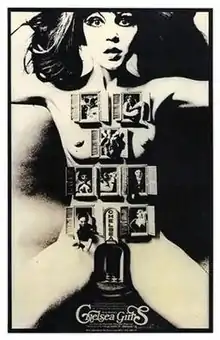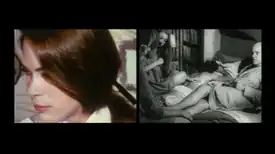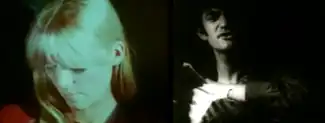| Chelsea Girls | |
|---|---|
 British theatrical release poster | |
| Directed by | Andy Warhol Paul Morrissey |
| Written by | Ronald Tavel Andy Warhol |
| Produced by | Andy Warhol |
| Starring |
|
| Cinematography | Andy Warhol Paul Morrissey (uncredited) |
| Music by | The Velvet Underground |
| Distributed by | Filmmakers Distribution Center |
Release date |
|
Running time | 210 minutes (approx.) |
| Country | United States |
| Language | English |
| Budget | $3,000 (approx.) |
Chelsea Girls is a 1966 American experimental underground film directed by Andy Warhol and Paul Morrissey. The film was Warhol's first major commercial success after a long line of avant-garde art films (both feature-length and short). It was shot at the Hotel Chelsea and other locations in New York City, and follows the lives of several of the young women living there, and stars many of Warhol's superstars. The film is presented in a split screen, accompanied by alternating soundtracks attached to each scene and an alternation between black-and-white and color photography. The original cut runs at just over three hours long.[1]
The film was the inspiration for star Nico's 1967 debut album, Chelsea Girl, which featured a ballad-like track titled "Chelsea Girls", which was written about the hotel and its inhabitants. The girl in the poster is Clare Shenstone, at the age of 16, an aspiring artist later influenced by Francis Bacon.[2] With its creativity and eroticism, the poster captures the sensual essence of the film, and was designed for its London release by graphic artist Alan Aldridge. Warhol was extremely happy with the design, and commented that he "wished the movie was as good as the poster".[3] The poster was used as the cover art for Felt's 1984 album The Splendour of Fear.
Production
According to scriptwriter Ronald Tavel, Warhol first brought up the idea for the film in the back room of Max's Kansas City, Warhol's favorite nightspot, during the summer of 1966. In Ric Burns' documentary film Andy Warhol, Tavel recollected that Warhol took a napkin and drew a line down the middle and wrote 'B' and 'W' on opposite sides of the line; he then showed it to Tavel, explaining "I want to make a movie that is a long movie, that is all black on one side and all white on the other." Warhol was referring to both the visual concept of the film, as well as the content of the scenes presented.
The film was shot in the summer and early autumn of 1966 in various rooms and locations inside the Hotel Chelsea, though contrary to the film's title, only poet René Ricard actually lived there at the time.[4] Filming also took place at Warhol's studio The Factory. Appearing in the film were many of Warhol's regulars, including Nico, Brigid Berlin, Gerard Malanga, Mary Woronov as Hanoi Hannah, Ingrid Superstar, International Velvet and Eric Emerson. According to Burns' documentary, Warhol and his companions completed an average of one 33-minute segment per week.
Once principal photography wrapped, Warhol and co-director Paul Morrissey selected the 12 most striking vignettes they had filmed and then projected them side by side to create a visual juxtaposition of both contrasting images and divergent content (the so-called "white" or light and innocent aspects of life against the "black" or darker, more disturbing aspects.) As a result, the 6.5 hour running time was essentially cut in half, to 3 hours and 15 minutes. However, part of Warhol's concept for the film was that it would be unlike watching a regular movie because the two projectors could never achieve exact synchronization from viewing to viewing; therefore, despite specific instructions of where individual sequences would be played during the running time, each viewing of the film would, in essence, be an entirely different experience.
Several of the sequences have gone on to attain a cult status, most notably the "Pope" sequence, featuring avant-garde actor and poet Robert Olivo, or Ondine as he called himself, as well as a segment featuring Mary Woronov titled "Hanoi Hannah," one of two portions of the film scripted specifically by Tavel.
Notably missing is a sequence Warhol shot with his most popular superstar Edie Sedgwick which, according to Morrissey, Warhol excised from the final film at the insistence of Sedgwick, who claimed she was under contract to Bob Dylan's manager Albert Grossman at the time the film was made. Sedgwick's footage was used in the Warhol film Afternoon.
Cast
The cast of the film is largely made up of persons playing themselves, and are credited as follows:
- Brigid Berlin as herself (The Duchess)
- Nico as herself
- Ondine as himself (Pope)
- Ingrid Superstar as herself
- Randy Bourscheidt as himself
- Angelina 'Pepper' Davis as herself
- Christian Aaron Boulogne as himself
- Mary Woronov as Hanoi Hannah
- Ed Hood as himself
- Ronna as herself
- International Velvet as herself
- Rona Page as herself
- Rene Ricard as himself
- Dorothy Dean as herself
- Patrick Fleming as himself
- Eric Emerson as himself
- Donald Lyons as himself
- Gerard Malanga as Son
- Marie Menken as Mother
- Arthur Loeb as himself
- Mario Montez as Transvestite
Critical reception

Although the film garnered the most commercial success of Warhol's films, reaction to it was mixed. On Rotten Tomatoes the film has an approval rating of 50%, based on reviews from 10 critics.[5] In the UK, it was refused a theatrical certificate in 1967 by the British Board of Film Classification.[6]
Roger Ebert reviewed the film in June 1967, and had a negative response to it, granting it one star out of four. In his review of the film, he stated, "what we have here is 3½ hours of split-screen improvisation poorly photographed, hardly edited at all, employing perversion and sensation like chili sauce to disguise the aroma of the meal. Warhol has nothing to say and no technique to say it with. He simply wants to make movies, and he does: hours and hours of them."[7] Variety wrote that the film was "a pointless, excruciatingly dull three-and-a-half hours spent in the company of Andy Warhol's friends."[8]
Kenneth Baker of the San Francisco Chronicle reviewed the film in honor of its screening in the San Francisco Bay Area in 2002, and gave the film a positive review, stating "The tyranny of the camera is the oppression The Chelsea Girls records and imposes. No wonder it still seems radical, despite all we have seen onscreen and off since 1966."[9] Jonathan Rosenbaum also gave the film a positive review, stating that "the results are often spellbinding; the juxtaposition of two film images at once gives the spectator an unusual amount of freedom in what to concentrate on and what to make of these variously whacked-out performers."[10] TV Guide reviewed the film in December 2006, granting it four stars, calling it "fascinating, provocative, and hilarious" and "a film whose importance as a 1960s cultural statement outweighs any intrinsic value it may have as a film."[11]
Availability
Home media
Chelsea Girls is largely unavailable for home video format. The film belongs to the Andy Warhol Foundation, and it, along with Warhol's other films (apart from a handful of his Screen Tests, which have since been released on DVD)[12] have never seen home video releases in the United States. In Europe, however, a handful of Warhol's films were released on DVD, including a short-lived DVD print of Chelsea Girls which was available in Italy for some time. This Italian DVD print, which is the film's only official home video release, was released on September 16, 2003.[13]
Museum screenings
While the film is unavailable for personal purchase, it is often screened at art museums, and has been shown at The Museum of Modern Art[14] (which owns a rare print of the film reels) as well as The Andy Warhol Museum in Pittsburgh, Pennsylvania. The film was screened in San Francisco for the first time in nearly 20 years at Castro Theatre in April 2002.[15] Screenings were held in 2010 at the Seattle Art Museum[16] and at the Varsity Theater in Chapel Hill, North Carolina,[17] in 2011 at the High Museum of Art in Atlanta, Georgia,[18] and the Block Museum of Art in Evanston, Illinois in 2016.[19] The full 3 1/2 hour version of the film was screened at the Brooklyn Museum in a custom built theatre within their edition of the Andy Warhol: Revelation exhibit from November 19, 2021 to June 19, 2022.[20]
See also
References
- ↑ "All Movie: The Chelsea Girls". AllMovie.Com. Retrieved 16 September 2009.
- ↑ "Man in the Mask". The Guardian. London. 16 October 2005. Retrieved November 18, 2012.
- ↑ "Online caption". Tate Gallery website.
- ↑ Leve, Ariel 'New York Storeys' The Sunday Times Magazine, 25 March 2007, pp. 40–51. p. 49
- ↑ "Chelsea Girls". Rotten Tomatoes. Retrieved 9 July 2009.
- ↑ Heins, Marjorie (September 11, 2007). Not in Front of the Children: 'Indecency,' Censorship, and the Innocence of Youth. Rutgers University Press. p. 208. ISBN 9780813543888.
- ↑ Ebert, Roger (27 June 1967). "Roger Ebert reviews "Chelsea Girls"". Chicago Sun-Times. Archived from the original on 11 January 2013. Retrieved 8 July 2009.
- ↑ "The Chelsea Girls". Variety. December 31, 1966. Retrieved September 8, 2017.
- ↑ Baker, Kenneth (11 April 2002). "Film flashes back to Warhol '60s / Rarely seen movie a near overdose of artist's voyeurism". San Francisco Chronicle. Retrieved 8 July 2009.
- ↑ Rosenbaum, Jonathan (26 October 1985). "The Chelsea Girls". Reader.
- ↑ "Review: The Chelsea Girls". TV Guide. 17 December 2006. Archived from the original on 6 March 2012. Retrieved 9 July 2009.
- ↑ "The 13 Most Beautiful Songs for Andy Warhol's Screen Tests DVD". Amazon.com. 7 April 2009. Retrieved 8 July 2009.
- ↑ "Chelsea Girls". Amazon.com. 16 September 2003. Retrieved 17 September 2009.
- ↑ "MOMA: The Chelsea Girls screening: 8 June 2007". Museum of Modern Art. Retrieved 8 July 2009.
- ↑ "San Francisco Cinematheque Film Calendar: April–July 2002". San Francisco Cinematheque. Archived from the original on 16 July 2011. Retrieved 9 July 2009.
- ↑ "Seattle Art Museum Film Calendar: May 21, 2010". Seattle Art Museum. Archived from the original on 24 May 2010. Retrieved 11 May 2010.
- ↑ http://www.ackland.org/visit/calendar.php?q=2010-11-18%5B%5D
- ↑ "High Presents "Modern Masters of Film: From Edison to Scorsese," with 11 Films from One of the World's Most Important Film Repositories". High Museum of Art. Archived from the original on 2014-10-06.
- ↑ "The Chelsea Girls". The Block Museum of Art. Retrieved 19 January 2019.
- ↑ "Brooklyn Museum: Andy Warhol: Revelation".
